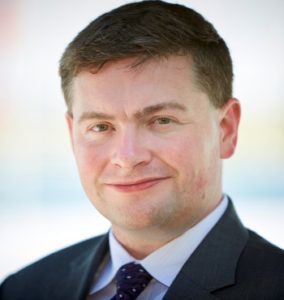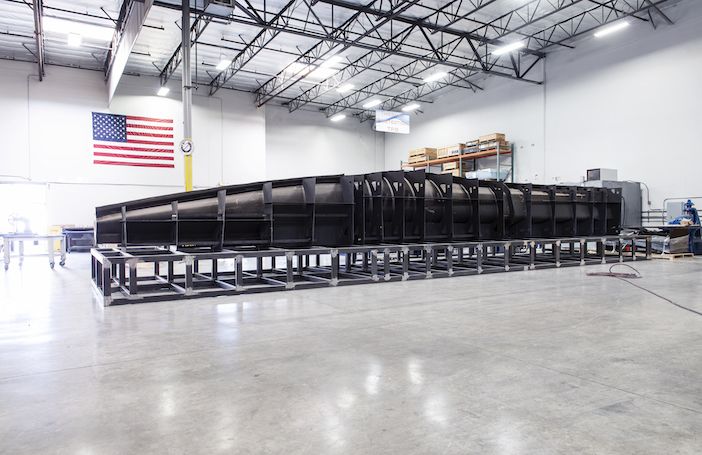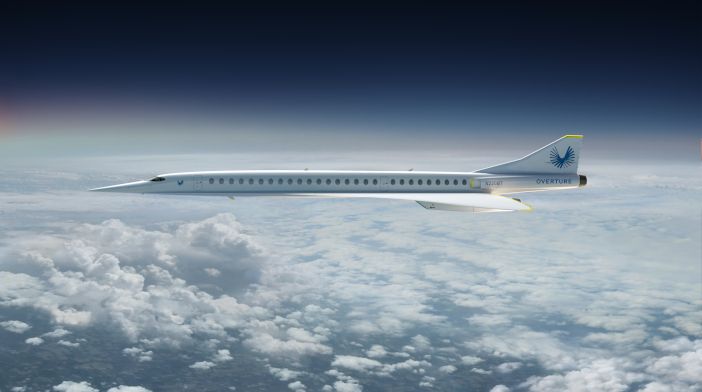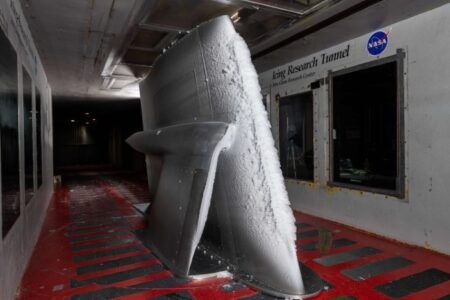by Robert Coppinger
The XB-1 demonstrator is leading the resurrection of commercial supersonic air travel. The technology demonstrator will test all of the key technologies for the 55-passenger Overture airliner being developed by Denver, Colorado-based firm Boom. This includes an almost all-composite frame, titanium components and innovations that will be used in the manufacturing processes.
“XB-1 is all about testing. The testing leads up to Overture. The entire purpose of the XB-1 program is to de-risk Overture by testing every key technology that goes into it and proving that it all actually works,” says Boom founder and CEO, Blake Scholl. To develop the XB-1 [See below, XB-1 Development], Scholl and his team have so far worked through more than 350 aerodynamic design iterations and carried out more than 1,000 materials tests and validations of key structural components such as, spars, ribs, tails, joints and mechanisms, such as actuators.

The testing also included the use of wind tunnels. The first wind tunnel test obtained calibration data for the tunnel and the scale-model. A further test was then conducted to confirm that the calibration was correct. “The third wind tunnel test was to confirm that the final design does with real air exactly what we think it should do, says Scholl. “We finished that late last year and got a clean bill of health out of the wind tunnel.”
A fourth wind tunnel test analyzed the performance of the engine inlets. With supersonic flight the friction between the supersonic air and the aircraft generates heat. For example, at Mach 2.0, the nose and leading edges can reach 242˚F. At Mach 2.2, the temperatures reach 307˚F and more if the day’s ambient temperature, is high.
Both XB-1 and Overture fly at Mach 2.2. Concorde flew at Mach 2.0. “We chose Mach 2.2 because it is fast enough to make a massive difference in travel, yet slow enough to require only known, proven basic technologies,” Scholl says.
The high temperatures at these speeds will damage the engine core, so the inlet is designed to slow the incoming air. “The process is to take the supersonic air, the Mach 2.2 air that’s coming at you, then slow it, compress it with the inlet and feed it to the engine at about half the speed of sound,” Scholl explains.
“We’ve done a lot of the work through finite element analysis [FEA] and computational fluid dynamics [CFD],” he says. “We use tools that were developed at NASA, plus tools that we developed in-house ourselves for CFD.”
As well as slowing and compressing the air, the inlet needs to provide uniform air flow, which is easier to achieve at subsonic speeds because the air goes straight into the engine. However, at supersonic speeds a much more complicated compression inducting system is required. Scholl says, “You’ve got to feed the air to the engine in a sufficiently uniform way that it’s not going to choke on you.”
Choking occurs when the air flow becomes compressed and its density increases to the point where its velocity slows down too much.
The wind tunnel tests included all the modes of flight from take-off, through ascent and cruise to over-speed conditions. “We tested at Mach 2.24. The team came back from that test and I said, ‘What are you going to do in the next iteration?’ They said, ‘There is no next iteration. We’re done.’ For a little while, I didn’t believe them. It’s a real testament to the team they’ve been able to put together what they pulled off,” Scholl proudly boasts.
Custom ovens
While the wind tunnel aided the development of the 350 plus aerodynamic iterations, Boom engineers conducted composite ply strength and resin system tests among the more than 1,000 material assessments. Both the XB-1 and Overture aircraft will be mostly composite, with some metallics including titanium components in the places where excessive heating is expected on the fuselage. The material tests were conducted in a variety of environments – from the very cold that the aircraft would experience at subsonic cruise at 30,000ft to the extreme heat which is experienced in supersonic cruise, with temperatures up to 350˚F, despite being at 60,000ft.
“We started doing a bunch of coupon tests and building up to joint testing, then to substructure testing,” says Scholl. “We built an entire horizontal tail for tests. We built the entire wingspan for tests. We built a custom oven that would take those up to 350˚F.”

Scholl’s team took the XB-1 horizontal tail, a 19.5kg part and subjected it to more than 10,000 lb (44.4kN) of loading at 350˚F. “You couldn’t do this just in metallics,” he says.
“We measured strength to find out how much load it can take before it fails. Then, when we did achieve failure, we did forensics on the parts so we could see exactly where they failed and where we would expect them to fail first.”
Engineers conducted destructive testing and would cut up the structures to see exactly what had happened internally. Scholl says, “When it finally did fail, the part that yielded was the titanium fitting that held it on. We haven’t even found the limits of the composites.”
Testing data in 3D
Boom has carried out some of its work at the National Institute for Aviation Research (NIAR) at Wichita State University. “We’ve done a lot of in-house testing and we’ve done some in partnership with NIAR,” says Scholl. “It’s a great lab.”
Boom partner Dassault Systèmes, which produces software for enterprise research and development, has established an innovation laboratory at NIAR. The 22,000 square foot facility has additive manufacturing and conventional manufacturing processes, robotic systems and a three-dimensional immersive reality cave; which is a room with a wrap-around screen.
“In the Dassault 3D experience platform, they have some built-in FEA that we use, which is great for sure,” says Scholl. Dassault’s software is called the 3D experience platform. “They’ve got some great tools for automating the composites lay out. I started to use those for the XB-1 and we’re using them extensively now.”
For the sub-system testing, Boom is using an iron bird. The aircraft’s actual sub-systems are laid out in a test centre and connected to ensure they can be integrated. “The entire flight control system is up and running, the hydraulic system is up and running and we have the heat exchangers for the environmental control system that are working on their own,” Scholl explains.

Boom has also tested manufacturing processes for XB-1. Fabrication of the composite fuselages and wings is a multi-step process starting with foam moulds, precision machined polyurethane masters, and autoclave-cured carbon skin moulds. “We also test for assembly,” says Scholl. “You can use CAD to see how it will be put together, but when you go to build it you’ll find that you can’t get your hand in there and turn the wrench.”
Mock-ups of the aircraft’s structures are being built so the assembly process can be practised. “There’s nothing like actually experiencing that with real hardware,” Scholl adds.
While Boom has selected and tested the engine for the XB-1, the General Electric J85-15, the engine for Overture is yet to be selected. However, its competitor, Aerion [See below, Return of supersonic flight?] announced in October last year that it would be using the General Electric Affinity engine.
Once the engines are integrated to the airframe and ground testing complete, XB-1 flight tests will take place in a designated supersonic corridor that is part of the United States Edwards Air Force Base in California, USA next year. “We would like there to be more supersonic corridors and we’re working on that,” says Scholl, which he clarifies as meaning discussing with aviation regulators and government.
The planned entry-into-service for Overture is in the mid-2020s. By that time it will be more than 20 years since Concorde’s retirement and more than 50 years since that aircraft’s 1969 flight tests. Only the testing still to come will determine whether commercial supersonic aircraft will be here before the sixtieth anniversary of Concorde’s first test flights.
XB-1 development
The XB-1, also known as the Baby Boom, is the sub-scale technology demonstrator for Boom’s supersonic airliner Overture. XB-1 is powered by three General Electric J85-15 engines, adapted by Boom for Mach-2.2 operation. However, the engines for Overture have not been selected.
After initial taxi tests at BOOM’s Centennial, Colorado headquarters, XB-1 will be transported to Mojave, California for a flight test campaign. The initial flights will focus on
takeoff, climb, subsonic cruise, approach, and landing, followed by supersonic flights.
XB-1 uses the same key technologies as Overture; carbon fibre composites, a delta wing planform and a variable-geometry propulsion system, where the engine inlets can be moved. The demonstrator has more than 3,700 parts, including custom composite structure, tricycle landing gear, flight control actuators, systems for pressurization and cooling, avionics, and a high-bandwidth telemetry system.
Return of supersonic flight?
Boom is one of two companies working to bring back commercial supersonic flight since the retirement of the Concorde fleets in 2003, the other being the Reno, Nevada-based Aerion. Both firms claim to have a strong business case for supersonic travel.
Boom already has orders for its 55-seat airliner, Overture. Between them, Japan Airlines and Virgin Group have ordered 30 of the aircraft. Japan Airlines has also invested US$10 million in Boom.
Aerion is developing the eight-seat, Mach 1.4, AS2 business jet, which is expected to start flight testing in 2023. Private jet provider Flexjet has ordered 20 AS2s. In February, it was announced that Boeing had invested in Aerion.
Last year, Boeing revealed its Mach 5 airliner concept at the American Institute of Aeronautics and Astronautics’ (AIAA) 2018 Aviation and Aeronautics Forum. This year, on June 19, Lockheed Martin unveiled its Quiet Supersonic Technology Airliner concept at the same AIAA aviation event. It is a twin-engine 40-seat aircraft with a cruise speed of Mach 1.8. Lockheed is building NASA’s X-59 Quiet SuperSonic Technology X-plane which will test technologies to reduce the sonic boom.





